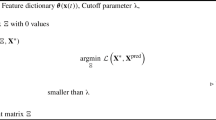Abstract
Research on model-based diagnosis of technical systems has grown enormously in the last few years, producing new basic tools, new algorithms and also some applications. However, the majority of research has dealt with systems described by variables ranging in discrete domains (e.g., digital circuits), and only few attempts have been made at applying such techniques to continuous domains. Continuous systems are characterized by additional problems, such as the unavoidable sensor errors and the need for using more complex models which may consist of simultaneous non-linear equations. The distinctive feature of the approach we present in this paper is the integration of techniques well known in the field of numerical analysis and statistics (e.g., the solution of non-linear systems and the error propagation) with a dependency-recording technique based on ordering the equations and the variables of the model.
Similar content being viewed by others
References
R. Davis, Diagnostic reasoning based on structure and behaviour, Artificial Intelligence 24 (1984) 347–410.
J. de Kleer and G.J. Sussman, Propagation of constraints applied to circuit synthesis, Circuit Theor. Appl. 8 (1980) 127–144.
J. de Kleer, An assumption-based truth maintenance system, Artificial Intelligence 28 (1986) 127–162.
J. de Kleer and B.C. Williams, Diagnosing multiple faults, Artificial Intelligence 32 (1987) 97–130.
J. de Kleer and B.C. Williams, Diagnosis with behavioral modes, in:Proc. 11th Int. Conf. on Artificial Intelligence, 1989, pp. 1324–1330.
J. de Kleer and B.C. Williams, Focusing the diagnosis engine, in:Proc. 1st Int. Workshop on Principles of Diagnosis, Stanford, CA, 1990.
M. Gallanti, M. Roncato, A. Stefanini and G. Tornielli, A diagnostic algorithm based on models at different levels of abstraction, in:Proc. 11th Int. Conf. on Artificial Intelligence, 1989, pp. 1350–1355.
B.J. Glass and C.M. Wong, A knowledge-based approach to identification and adaptation in dynamic systems control, in:Proc. 27th IEEE Conf. on Decision and Control, Austin, TX, 1988, pp. 881–886.
W.C. Hamscher, Model-based troubleshooting of digital systems, Technical Report 1074, MIT Artificial Intelligence Lab. (August 1988).
Y. Iwasaki and H.A. Simon, Causality in device behaviour, Artificial Intelligence 29 (1986) 3–32.
S. Narasimhan and R.S.H. Mah, Generalized likelihood ratio method for gross error identification, AIChE J. 33 (1987) 1514–1521.
P. Struss and O. Dressler, Physical negation — Integrating fault models into the General Diagnostic Engine, in:Proc. 11th Int. Conf. on Artificial Intelligence, 1989, pp. 1318–1323.
G.J. Sussman and G.L. Steele, CONSTRAINTS — A language for expressing almost-hierarchical descriptions, Artificial Intelligence 14(1) (1980).
Author information
Authors and Affiliations
Rights and permissions
About this article
Cite this article
Cermignani, S., Tornielli, G. Model-based diagnosis of continuous static systems. Ann Math Artif Intell 11, 367–380 (1994). https://doi.org/10.1007/BF01530751
Issue Date:
DOI: https://doi.org/10.1007/BF01530751




